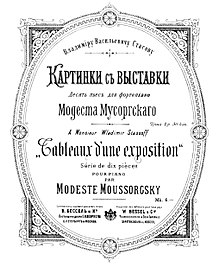Pictures at an Exhibition
Pictures at an Exhibition is a piece of music for solo piano composed by Modest Mussorgsky in 1874. It is Mussorgsky’s most famous solo piano work and often played by virtuosos to show how good they are. Many years after Mussorgsky’s death, Maurice Ravel made an arrangement of the piece for orchestra. This version, by a Russian composer and a French arranger, is how people usually hear the music today.
Composition history[change | change source]

Pictures at an Exhibition is a musical description of an exhibition of pictures by the painter Viktor Hartmann. Hartmann was only 39 when he died in 1873. He and Mussorgsky had been good friends. They both tried to give their works a very Russian character: Hartmann through his pictures and Mussorgsky through his music. In 1874 an exhibition of Hartmann’s pictures was organised in the Academy of Fine Arts in St Petersburg. Mussorgsky went to the exhibition and was inspired to compose his piano piece.
Pictures at an Exhibition describes someone walking round the exhibition and looking at the pictures. The ten pictures he describes in music were drawings and watercolours. Mussorgsky starts his piece with a tune which describes the person walking round the exhibition. It is usually known as the “promenade” theme (a promenade is a walk). At first Mussorgsky puts the promenade theme between each picture, but he does not do that all the way through the piece. Some of the later pictures have bits of the promenade theme in the music.
Publication history[change | change source]

Mussorgsky composed the piece very quickly. It was not published until 1886, five years after the composer’s death. The composer’s great friend Nikolai Rimsky-Korsakov published it, but he made some changes to what Mussorgsky had written. It was not until 1931 that an edition was published which tried to show exactly what Mussorgsky had written.
Gallery of Hartmann’s pictures[change | change source]
Four of the pictures that Mussorgsky described in his music:
-
A rich Jew
-
A poor Jew
-
Paris Catacombs
-
Plan for a city gate in Kiev
Description of the music[change | change source]
- The Promenade theme describes a person walking round the exhibition. It has lots of important-sounding chords. Mussorgsky wrote it with a time signature of 11/4, although it is usually written nowadays in 5/4 and 6/4 time.

These are the ten pictures which are then described in Mussorgsky’s music:
- No. 1 "Gnomus" : This describes a little gnome with crooked legs trying to run around. Hartmann’s sketch may be a drawing of a toy nutcracker.
- No. 2 "The Old Castle" describes an old medieval castle. A troubadour is singing a song in front of the castle. It is a gentle, rather sad song. In Ravel’s version for orchestra the tune is played on the alto saxophone.
- No. 3 "Tuileries" describes children playing in a park called Tuileries which is in the centre of Paris. It has a little tune which sounds like children singing a teasing song.
- No. 4 "Bydło" describes a cart which is being pulled by oxen. In Ravel’s orchestral version the tune is played by the tuba. It sounds very low and heavy.
- No. 5 The Ballet of the Unhatched Chicks" describes little canary chicks which are still in their eggs. The picture was based on a ballet which had been produced in 1870.
| Ballet des poussins dans leurs coques (1:18) | |
- No. 6 "Samuel Goldenberg und Schmuÿle" describes two Jews. One is rich and the other one is poor.
- No. 7 "The Market at Limoges" describes French women quarreling in the market. Limoges is a city in central France.
- No. 8 "The Catacombs" describes the dark Paris catacombs with loud and soft chords. The promenade theme is heard in a ghostly form.
- Problems playing the files? See media help.
| Catacombae, Sepulcrum romanum (1:53) | |
| Cum mortuis in lingua mortua (1:50) | |
- No. 9 "The Hut on Fowl’s Legs" is about a picture in which Hartmann draws a clock in the form of Baba-Yaga's hut on hen's legs
- No. 10 "The Great Gate of Kiev" ("The Bogatyr Gates") was inspired by Hartmann's drawing for a huge gate which was to be built to remember how the Tsar had escaped assassination on 4 April 1866. The design won a prize, but the gate was never built.[1][2]
Notes[change | change source]
References[change | change source]
- Calvocoressi, M.D., Modest Mussorgsky: His Life and Works, London: Rockliff, 1956






